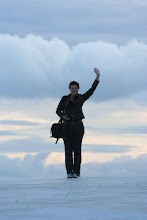


 Ez egy kondenzcsíkokon gyakran látható jelenség, és némileg hasonlít a mammatus felhőkhöz. Amikor a repülőgép 500 mérföld/órás sebességnél gyorsabban repül, turbulenciát (wake turbulence) hoz létre, mely egymástól egyenlő távolságban lévő örvényekből áll (wake vortices). Amennyiben a kondenzcsík sűrűbb, ilyen szabályos "fogakat" figyelhetünk meg rajta. Kialakulása sokmindentől függ: a repülőgép sebességétől, méretétől és a levegő tulajdonságaitól egyaránt. A fenti képek az elmúlt három hónapban készültek Vecsésen.
Ez egy kondenzcsíkokon gyakran látható jelenség, és némileg hasonlít a mammatus felhőkhöz. Amikor a repülőgép 500 mérföld/órás sebességnél gyorsabban repül, turbulenciát (wake turbulence) hoz létre, mely egymástól egyenlő távolságban lévő örvényekből áll (wake vortices). Amennyiben a kondenzcsík sűrűbb, ilyen szabályos "fogakat" figyelhetünk meg rajta. Kialakulása sokmindentől függ: a repülőgép sebességétől, méretétől és a levegő tulajdonságaitól egyaránt. A fenti képek az elmúlt három hónapban készültek Vecsésen.Hasznos link: contrailscience.com
This phenomenon can often be observed on condensation trails, and is a little similar to mammatus clouds. When the airplane flies at more than 500 mph, it creates wake turbulence, made up of regularly patterned wake vortices. When the contrail is denser, we can see pendules clinging from it. Their formation depends on several factors, such as the speed and size of the aircraft and the characteristics of the air that it flies through. The above photos were taken this summer and autumn in Vecsés, Hungary.
Useful link: contrailscience.com






No comments:
Post a Comment